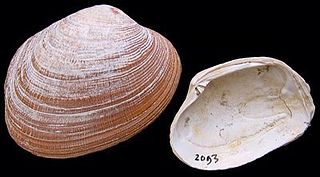
Subsidence is a general term for downward vertical movement of the Earth's surface, which can be caused by both natural processes and human activities. Subsidence involves little or no horizontal movement, which distinguishes it from slope movement.

Bivalvia or bivalves, in previous centuries referred to as the Lamellibranchiata and Pelecypoda, is a class of aquatic molluscs that have laterally compressed soft bodies enclosed by a calcified exoskeleton consisting of a hinged pair of half-shells known as valves. As a group, bivalves have no head and lack some typical molluscan organs such as the radula and the odontophore. Their gills have evolved into ctenidia, specialised organs for feeding and breathing.

Betacoronavirus pandemicum is a species of virus consisting of many known strains. Two strains of the virus have caused outbreaks of severe respiratory diseases in humans: severe acute respiratory syndrome coronavirus 1, the cause of the 2002–2004 outbreak of severe acute respiratory syndrome (SARS), and severe acute respiratory syndrome coronavirus 2 (SARS-CoV-2), the cause of the pandemic of COVID-19. There are hundreds of other strains of SARSr-CoV, which are only known to infect non-human mammal species: bats are a major reservoir of many strains of SARSr-CoV; several strains have been identified in Himalayan palm civets, which were likely ancestors of SARS-CoV-1.

The Gendarmerie General Command is the national gendarmerie force of the Republic of Turkey. It is a service branch of the Turkish Ministry of Interior responsible for the maintenance of the public order in areas that fall outside the jurisdiction of police forces, as well as assuring internal security along with carrying out other specific duties assigned to it by certain laws and regulations. In wartime, some of its elements can be subordinated to Turkish Land Forces by the President of Turkey.

Shiv Dayal Singh, known by the honorific "Param Purush Puran Dhani Huzur Soami Ji Maharaj" by his disciples and devotees, was an Indian spiritual guru and founder of Radha Soami, a 19th-century spiritual sect.

Salanter Akiba Riverdale High School is a Modern-Orthodox Jewish day school located in the Riverdale section of The Bronx, New York. It was founded in 2003 by Rabbi Naftali (Tully) Harcsztark. The school is affiliated with SAR Academy, which is also in Riverdale.

The Buccinidae are a very large and diverse taxonomic family of large sea snails, often known as whelks or true whelks.
Freshwater bivalves are molluscs of the order Bivalvia that inhabit freshwater ecosystems. They are one of the two main groups of freshwater molluscs, along with freshwater snails.

Thyasiridae is a family of bivalve molluscs, including the cleft clams, in the order Lucinida.
Sportellidae is a family of marine bivalve molluscs of the superfamily Cyamioidea.

Sentinel-1 is the first of the Copernicus Programme satellite constellations conducted by the European Space Agency. The mission was originally composed of a constellation of two satellites, Sentinel-1A and Sentinel-1B, which shared the same orbital plane. Two more satellites, Sentinel-1C and Sentinel-1D are in development. Sentinel-1B was retired following a power supply issue on December 23, 2021, leaving Sentinel-1A the only satellite of the constellation currently operating. Sentinel-1C has been successfully launched on 5 December 2024, 21:20 UTC, but is still ongoing in-orbit test before fully operational.

The grooved carpet shell, or Palourde clam, Ruditapes decussatus, or Venerupis decussatus, is a clam in the family Veneridae. It is distributed worldwide and is highly prized due to its ecological and economic interest. It has been proposed as a bioindicator.

SAR or Harosa is a highly diverse clade of eukaryotes, often considered a supergroup, that includes stramenopiles (heterokonts), alveolates, and rhizarians. It is a node-based taxon, including all descendants of the three groups' last common ancestor, and comprises most of the now-rejected Chromalveolata. Their sister group has been found to be telonemids, with which they make up the TSAR clade.

Oenopota is a genus of sea snails, marine gastropod mollusks in the family Mangeliidae.

Bela is a genus of sea snails; marine gastropod mollusks in the family Mangeliidae.
Cuspidaria is a genus of bivalves in the family Cuspidariidae.

Severe acute respiratory syndrome coronavirus 2 (SARS‑CoV‑2) is a strain of coronavirus that causes COVID-19, the respiratory illness responsible for the COVID-19 pandemic. The virus previously had the provisional name 2019 novel coronavirus (2019-nCoV), and has also been called human coronavirus 2019. First identified in the city of Wuhan, Hubei, China, the World Health Organization designated the outbreak a public health emergency of international concern from January 30, 2020, to May 5, 2023. SARS‑CoV‑2 is a positive-sense single-stranded RNA virus that is contagious in humans.
Allison Joan McGeer is a Canadian infectious disease specialist in the Sinai Health System, and a professor in the Department of Laboratory Medicine and Pathobiology at the University of Toronto. She also appointed at the Dalla Lana School of Public Health and a Senior Clinician Scientist at the Lunenfeld-Tanenbaum Research Institute, and is a partner of the National Collaborating Centre for Infectious Diseases. McGeer has led investigations into the severe acute respiratory syndrome outbreak in Toronto and worked alongside Donald Low. During the COVID-19 pandemic, McGeer has studied how SARS-CoV-2 survives in the air and has served on several provincial committees advising aspects of the Government of Ontario's pandemic response.

Z-Library is a shadow library project for file-sharing access to scholarly journal articles, academic texts and general-interest books. It began as a mirror of Library Genesis, but has expanded dramatically.

Variants of severe acute respiratory syndrome coronavirus 2 (SARS-CoV-2) are viruses that, while similar to the original, have genetic changes that are of enough significance to lead virologists to label them separately. SARS-CoV-2 is the virus that causes coronavirus disease 2019 (COVID-19). Some have been stated, to be of particular importance due to their potential for increased transmissibility, increased virulence, or reduced effectiveness of vaccines against them. These variants contribute to the continuation of the COVID-19 pandemic.















